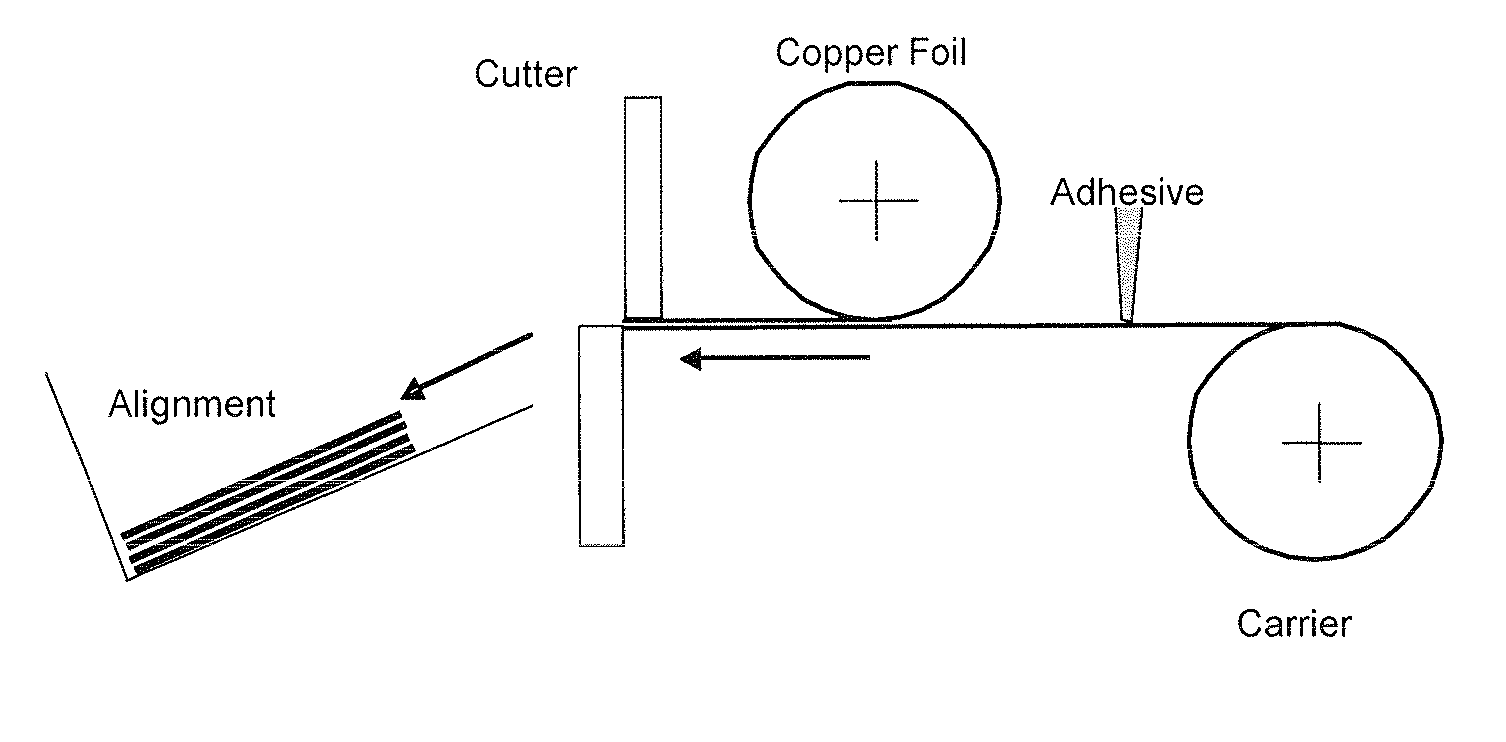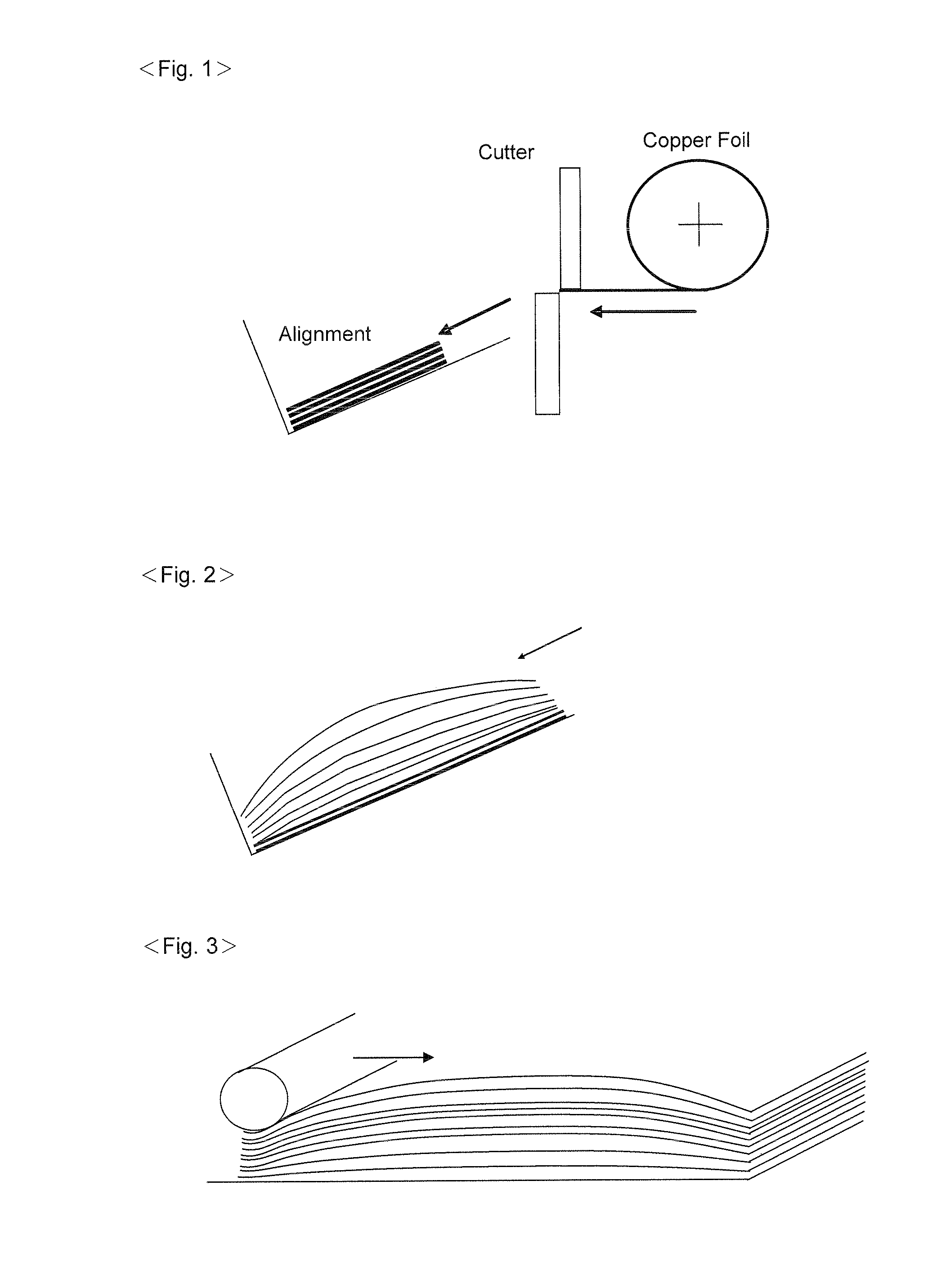Method of Producing Laminated Body, and Laminated Body
a technology applied in the field of laminated body and body, can solve the problems of deteriorating work efficiency, affecting the quality of laminated body, and requiring workers considerable force and time, and achieves superior effect, improved handling ability, and easy peeling.
- Summary
- Abstract
- Description
- Claims
- Application Information
AI Technical Summary
Benefits of technology
Problems solved by technology
Method used
Image
Examples
example 1
[0118]An aluminum foil of 40 μm was used as the carrier A, and a copper foil of 35 μm was used as the foil to be bonded thereto. An adhesive with a viscosity of 2,000,000 to 3,000,000 mPA·S was used, and applied at an application width of 3 mm at both facing ends while winding off the carrier A from a bobbin. The adhesive was applied linearly.
[0119]The metal foil B was laid on and bonded to a side to which the adhesive was applied while being wound off from a bobbin, the obtained laminated body was subsequently cut, the cut laminated bodies were aligned, and a roller was applied from the top of an object to be cut (air-vent).
[0120]Consequently, bonding was possible in a state that is free from the generation of wrinkles and cracks with the viscosity being 2,000,000 to 3,000,000 mPA·S.
[0121]When the viscosity was 5,000,000 mPA·S, wrinkles occurred and the laminated body became defective.
example 2
[0122]An aluminum foil of 12 μm was used as the carrier A, and a copper foil of 9 μm was used as the foil to be bonded thereto. An adhesive with a viscosity of 800,000 to 900,000 mPA·S was used, and applied at an application width of 3 mm. The adhesive was applied linearly. The process from bonding to roller application was the same as Example 1.
[0123]Since the carrier and the copper foil were thin, bonding was possible in a state that is free from the generation of wrinkles and cracks with the viscosity being 800,000 to 900,000 mPA·S, which is a range that is smaller than Example 1, even though some lenticulation could be observed.
[0124]Meanwhile, when the viscosity was 2,000,000 mPa·S, wrinkles occurred and the laminated body became defective.
[0125]Accordingly, it has been confirmed that it is necessary to adjust the viscosity of the adhesive to be applied depending on the material and thickness of the carrier A.
example 3
[0126]An aluminum foil of 18 μm was used as the carrier A, and a copper foil of 5 μm was used as the foil to be bonded thereto. An adhesive was applied linearly at an application width of 3 mm. The process from bonding to roller application was the same as Example 1.
[0127]In the foregoing case, since the copper foil was even thinner than Example 2, bonding was possible in a state that is free from the generation of wrinkles and cracks with the viscosity being 8000 to 10000 mPA·S, even though some lenticulation could be observed.
[0128]Meanwhile, when the viscosity was 1,500,000 mPA·S, wrinkles occurred and the laminated body became defective.
[0129]Accordingly, in this case also, it has been confirmed that it is necessary to adjust the viscosity of the adhesive to be applied depending on the material and thickness of the carrier A.
PUM
| Property | Measurement | Unit |
|---|---|---|
| yield stress | aaaaa | aaaaa |
| thickness | aaaaa | aaaaa |
| thickness | aaaaa | aaaaa |
Abstract
Description
Claims
Application Information
 Login to View More
Login to View More - R&D
- Intellectual Property
- Life Sciences
- Materials
- Tech Scout
- Unparalleled Data Quality
- Higher Quality Content
- 60% Fewer Hallucinations
Browse by: Latest US Patents, China's latest patents, Technical Efficacy Thesaurus, Application Domain, Technology Topic, Popular Technical Reports.
© 2025 PatSnap. All rights reserved.Legal|Privacy policy|Modern Slavery Act Transparency Statement|Sitemap|About US| Contact US: help@patsnap.com



